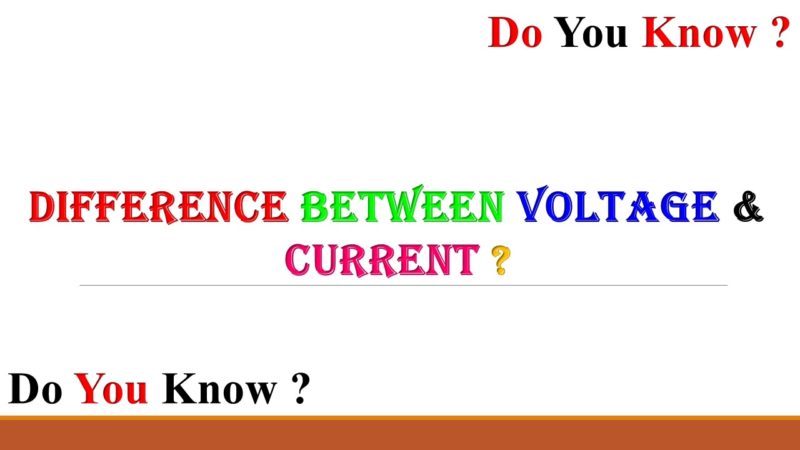What is the difference between voltage and current?
Electrical engineering tends to entail the study of voltage and current. These two aspects of electricity tend to sound similar but they have quite a different meaning.
The main difference between current and voltage is that current is the rate of flow of electric charges while voltage is the difference of electric potential between two points.

Comparison Table between Voltage and Current
| Basic Terms | Voltage | Current |
| Description | It is the difference of electric potential between two points or it is energy per unit charge | It is the rate of flow of electric charges in a circuit at a particular point |
| SI unit | Volts (V) | Ampere (A) |
| Denoted As | V | I |
| Measuring Instrument | Voltmeter | Ammeter |
| Inter-relation | Cause of electric current | Current is as a result of voltage |
| Formula for Calculation | V= Work done/Charge | I= Charge/ Time |
| Loss | Due to impedance | Due to the passive elements |
| Type of Field Created | Electrostatic Field | Magnetic Field |
| Change in Connection Series | Voltage changes | Current remains the same |
| Change in Parallel Connection | Voltage remains the same | Current changes |
| Polarity Changes | AC changes its polarity and magnitude while DC remain constant | AC changes its polarity by DC cannot |
| Existence | Can exist without current since it is the cause of the charges | Cannot exist without voltage |
| Types | Alternating voltage and direct voltage | Alternating current and direct current |
| Produces | Alternator | Voltage |
| Charges | 1 Volt = 1 Joule/ Coulomb | 1 Amperes = 1 coulomb /second |
What Is Voltage?
A voltage is a difference in electric potential between two points. It is the driving force in an electric circuit for the formation of current.
The symbol of voltage is V and the SI unit is Volt. The basic types of voltage are alternating voltage and direct voltage.
An alternating voltage is generated by alternators and they can change the voltage direction and its magnitude.
Direct voltage is generated by electrochemical cells and batteries. It does not change the polarity of voltage but ensures it has a constant magnitude.
What Is Current?
Current is the flow of charges through a cross-sectional area. It is produced due to the flow of either negative charges or positive charges.
The main symbol of current is I and the SI unit is Amperes. The basic types of current are alternating current and direct current.
Alternating current tends to change the current direction and magnitude continuously throughout time.
Direct current has a constant magnitude and it does not change its polarity. Both polarity and direction tend to remain the same throughout the time.
Main Difference between Voltage and Current in Point Form
- Voltage is the difference of electric potential between two points whereas the current is the flow of charges through a cross-sectional area.
- The SI unit of voltage is volts while that of current in amperes
- The voltage is denoted as V while current is denoted as I
- Voltage generate magnetic field while current generated voltage field
- A voltmeter is used to measure voltage while ammeter is used to measure current
- Basic types of voltage are alternating and direct voltage while those of current is alternating and direct current
- The loss of voltage is due to impedance while that of current is due to passive elements in the circuit
- Voltage cause current to occur while the current occurs as a result of voltage
- Series connection changes voltage whereas current remains the same throughout the time
- Parallel connection changes currently whereas voltage remains the same throughout the time
Similarities between Voltage and Current
- Both entail electric circuit
- Both determine how much power is dissipated across the circuit
- Both can be alternating polarity and direct polarity
- Both are directly proportional according to ohm’s law
Frequently Asked Questions (Voltage vs Current)
- What is Dangerous Voltage or Current?
Current. It can cause an individual to receive an electrical shock. It involves a flow of charges within a cross-sectional area.
- Can There Be Voltage Without Current?
Yes, Voltage causes current to occur. But current cannot flow without voltage.
- Can DC Current Kill You?
Yes. But keep in mind that both DC and AC shock tend to be quite lethal. More DC current can kill you.
- Is Lightning AC or DC Electricity?
It is more like an impulse signal or a series of occurrences of impulse signals. Hence, it is neither AC nor DC.
Comparison Video
Summary
The core difference between voltage and current is that voltage is the difference of electric potential between two points while current is the flow of charges in a circuit.
Hence, the voltage can exist without current but current cannot exist without voltage. These are the two major aspects of electricity.
More Sources and References
- Voltage. Wikipedia
- Voltage and Current. All About Circuit